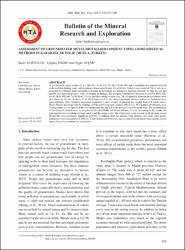Assessment of groundwater metal-metalloid content using Geostatistical methods in Karabağlar Polje (Muğla, Turkey)
Abstract
In this research, heavy metals (Ti, Cr, Mn, Fe, Co, Ni, Cu, Zn, Mo, Cd, Ba, Pb) and a metalloid (As) sampled from 84 wells used for drinking water and irrigation in Karabaglar Karstic Polje (Muğla, Turkey) were analyzed. The results were evaluated by different statistical methods in order to investigate the interaction between elements. Ti, Mn, Fe, Zn, Mo and Pb were detected in many wells. According to findings, the strongest correlation is between As and Cu (R=0.832). As-Ni (R=0.789) and Cu-Ni (R=0.776) are the other strong correlations. The relationship between these elements were also shown by Cluster Analysis (CA). With respect to CA, the closest proximity distance matrix are found for these three elements. Also, elements examined composed 3 main clusters in dendrogram created from CA result matrix. These clusters match up with the findings of Principal Component Analysis (PCA) too. PCA gathers all elements up in 3 components: As, Cu and Ni at the first component; Mo and Cd at the second; Cr and Ba at the third. The accumulation of the elements studied were investigated by Kruskal-Wallis and Mann-Whitney U tests. According to the results, the least and the most common elements are Cu and Ba, respectively. The differences in the amount of all elements except Ni and Mo were statistically significant (p<0.05). In addition, both the amount of the elements and some water quality parameters were compared with EPA (U. S. Environmental Protection Agency) and Turkish inland water quality classes and no hazardous situation has been found.


















